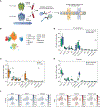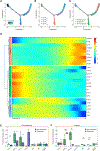Circulating monocytes associated with anti-PD-1 resistance in human biliary cancer induce T cell paralysis
- PMID: 36130508
- PMCID: PMC10060099
- DOI: 10.1016/j.celrep.2022.111384
Circulating monocytes associated with anti-PD-1 resistance in human biliary cancer induce T cell paralysis
Abstract
Suppressive myeloid cells can contribute to immunotherapy resistance, but their role in response to checkpoint inhibition (CPI) in anti-PD-1 refractory cancers, such as biliary tract cancer (BTC), remains elusive. We use multiplexed single-cell transcriptomic and epitope sequencing to profile greater than 200,000 peripheral blood mononuclear cells from advanced BTC patients (n = 9) and matched healthy donors (n = 8). Following anti-PD-1 treatment, CD14+ monocytes expressing high levels of immunosuppressive cytokines and chemotactic molecules (CD14CTX) increase in the circulation of patients with BTC tumors that are CPI resistant. CD14CTX can directly suppress CD4+ T cells and induce SOCS3 expression in CD4+ T cells, rendering them functionally unresponsive. The CD14CTX gene signature associates with worse survival in patients with BTC as well as in other anti-PD-1 refractory cancers. These results demonstrate that monocytes arising after anti-PD-1 treatment can induce T cell paralysis as a distinct mode of tumor-mediated immunosuppression leading to CPI resistance.
Trial registration: ClinicalTrials.gov NCT02703714.
Keywords: CP: Cancer; biliary tract cancer; checkpoint inhibitors; cholangiocarcinoma; immunotherapy; monocytes; myeloid cells.
Copyright © 2022 The Author(s). Published by Elsevier Inc. All rights reserved.
Conflict of interest statement
Declaration of interests L.F. has received research support (to institution) from Abbvie, Amgen, Bavarian Nordic, Bristol Myers Squibb, Dendreon, Janssen, Merck, Roche/Genentech, and Partner Therapeutics. L.F. has received compensation for serving on the scientific advisory boards (to self) for Actym, Alector, Astra Zeneca, Atreca, Bioatla, Bolt, Bristol Myers Squibb, Immunogenesis, Merck, Merck KGA, Nutcracker, RAPT, Scribe, Senti, Soteria, TeneoBio, and Roche/Genentech. C.J.Y. is a co-founder of Dropprint Genomics, is a Scientific Advisory Board member for and holds equity in Related Sciences and ImmunAI, is a consultant for and holds equity in Maze Therapeutics, is a consultant for TReX Bio, and has received research funding from Genentech. B.K. has received research support (to institution) from Partner Therapeutics. R.K.K. has received research support (to institution) from Agios, Astra Zeneca, Bayer, BMS, Eli Lilly, EMD Serono, Exelixis, Genentech/Roche, Merck, Novartis, Partner Therapeutics, QED, Relay Therapeutics, and Taiho. R.K.K. has received compensation for consulting or IDMC membership from Exact Sciences, Genentech/Roche, and Gilead (to self) and from Agios, Astra Zeneca, BMS, and Merck (to institution).
Figures





References
-
- Akkari L, Gocheva V, Kester JC, Hunter KE, Quick ML, Sevenich L, Wang HW, Peters C, Tang LH, Klimstra DS, et al. (2014). Distinct functions of macrophage-derived and cancer cell-derived cathepsin Z combine to promote tumor malignancy via interactions with the extracellular matrix. Genes Dev. 28, 2134–2150. 10.1101/gad.249599.114. - DOI - PMC - PubMed
-
- Antonarakis ES, Piulats JM, Gross-Goupil M, Goh J, Ojamaa K, Hoimes CJ, Vaishampayan U, Berger R, Sezer A, Alanko T, et al. (2020). Pembrolizumab for treatment-refractory metastatic castration-resistant prostate cancer: multicohort, open-label phase II KEYNOTE-199 study. J. Clin. Oncol. 38, 395–405. 10.1200/JCO.19.01638. - DOI - PMC - PubMed
Publication types
MeSH terms
Substances
Associated data
Grants and funding
LinkOut - more resources
Full Text Sources
Other Literature Sources
Medical
Molecular Biology Databases
Research Materials
Miscellaneous

